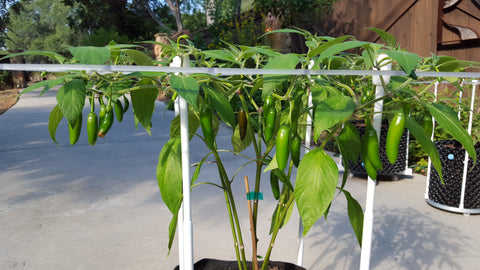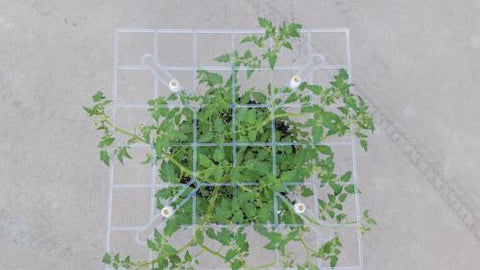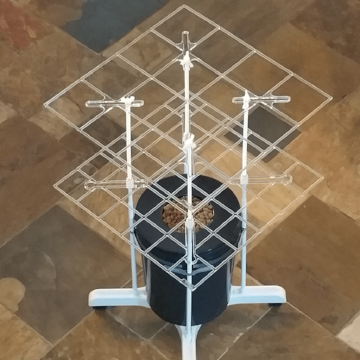Plant Training Techniques

Plant Cultivation

Pepper plant in P SCROG
What starts as a closet hobby quite often turns into a labor of love for many people, and for some a career. But one thing for sure, if your patience gets you through one or two grows, you will probably start seeking techniques that will improve future crops. Training techniques can substantially improve yield while dramatically reducing grow space requirements and lighting needs.
MAX YIELD made simple
You don't have to be an expert to maximize yield. There are an abundance of excellent references on the internet, but here is a sampling of the most notable techniques:
-
Super Cropping - bending/deforming branches, high stress
-
Lollipopping - removing lower vegetation
- Topping - cutting plant above top node
-
FIMming - partial pinching of new growth above top node site
- LST - Low Stress Training, bending but not deforming
- SOG - "Sea of Green", high plant densities, short veg cycles
- ScrOG - "Screen Of Green" is typically associated with one plant and utilized in conjunction with other advanced training techniques. Scrogging a plant increases yield and reduces grow space requirements.

LBH's Famous ScrOG Tutorial

The ScrOG method utilizes a screen with multiple openings typically suspended between the planting medium and the lighting source. Plant tips grow up to the screen and then are "trained" to grow horizontally using LST at the screen's planar surface during the vegetative cycle. The method results in a flat surface of plant growth with multiple bud sites relatively equal distance from the light source. Once the screen's inferior surface is filled with vegetation, lighting is switched to 12/12 and flowers are allowed to grow vertically through the screen openings and rising at approximately the same rate and equal distance from the light. Because all the buds are growing at the same height, it is possible to get all the growth within the effective footprint of the light source and ScrOG, maximizing production from the space.
Examples of veggie ScrOGs
Serrano Pepper, Roma & Cherry Tomato and Tamarillo Plants






Giant tamarillo plant (tree tomato) lollipopped and ScrOGged
Examples of other ScrOGs


Building ScrOGs
Search YouTube for hundreds of helpful DIY ScrOG videos to view.

DIY ScrOGs
Pros and Cons
Ounce for ounce...pound for pound, use of a ScrOG is one of the best investments a grower can make in a garden. The pros far outweigh the cons. Although the techniques are simple, scrogging and maintaining maturing plants is not without its frustrations and limitations.
Pros
- Increases yield and quality
- Promotes even canopy light penetration
- Improves light source efficiency
- Improved lighting ROI with greater usable production per watt
- Reduces grow space requirements
- Greater production per square foot of space
- Greater production per cubic foot in vertical farming
- "Trellis like" support of heavy/dense flowers
- Improved air circulation
Cons
- Complicated
- Tools required
- Time commitment / trial and error
- Saggy trellis net makes training plants difficult and nearly impossible to produce a flat canopy.
- Sloppy trellis, bamboo, PVC appearance
- Fixed screen forces grower to treat all strains / all plants under the ScrOG in the same manner.
- Fixed screen makes lollipopping, pruning and regular grooming of plants difficult.
- Once established in the ScrOG plants cannot be easily moved without trauma and/or damage to ScrOG and/or plants.
- Not easily adjusted
- ScrOG material can block light. Some DIY ScrOG material, especially metal, can block as much as 13% of the light rays available to the plant canopy and may conduct heat, especially if dark in color. This heat generation in direct contact may retard growth and damage plants.
- Difficult for grower to reach plants deep in ScrOG
- Difficult to change hydroponic nutrients or maintain organics.
- Difficult to manage drain pans and test nutrients
"Interested in Scrog but my plants move during cycle change. I can't be the only one with this problem." - OpenGrow.com


P SCROG Systems are the world's first commercially available completely portable and adjustable ScrOG systems that allow growers to train plants based on their individual needs regardless of strain, maturity level, health status or any other unique requirement. P SCROG screens are made from transparent polycarbonate resin allowing nearly all light to penetrate and are virtually indestructible. Don't care to DIY? Try P SCROG...it's simple.

Patented in USA
MAX YIELD MADE SIMPLE
ASSEMBLES IN MINUTES
NO TOOLS REQUIRED
FREE US SHIPPING
on orders $99 +

